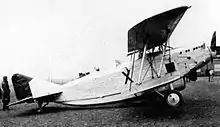ACAZ C.2
The ACAZ C.2, Ateliers de Construction Aeronautique de Zeebruge, was a prototype Belgian biplane fighter aircraft built in the 1920s.
| ACAZ C.2 | |
|---|---|
.jpg.webp) | |
| Role | Training Fighter |
| National origin | Belgium |
| Manufacturer | ACAZ (Ateliers de Construction Aeronautique de Zeebruge)[1] |
| First flight | 1926 |
| Number built | 1[1] |
Design and development
Built entirely of Duralumin metal, it was an advanced design at the time of its first flight in 1926, but although evaluated by the Belgian Air Force, no orders were placed. Of conventional biplane construction, the C.2, registered as O-BAFX, later OO-AFX, incorporated one unique feature - all four of its wings were identical and interchangeable. The aircraft also included space for cameras, allowing it to be used for photo-reconnaissance.[1]
Operational history
The C.2 was used in a failed aerial expedition by Edmond Thieffry, who with two companions (Joseph Lang and Philippe Quersin), attempted to fly it to Belgian Congo, departing Belgium on 9 March 1928, but only getting as far as Philippeville (Belgium).
The sole prototype was written off in a crash on 25 January 1933.[1]

Specifications (ACAZ C.2)

Data from The Complete Book of Fighters[1]
General characteristics
- Crew: 2
- Length: 8.25 m (27 ft 1 in)
- Wingspan: 12.5 m (41 ft 0 in)
- Height: 3.4 m (11 ft 2 in)
- Wing area: 40.56 m2 (436.6 sq ft)
- Empty weight: 1,260 kg (2,778 lb)
- Gross weight: 2,070 kg (4,564 lb)
- Powerplant: 1 × Hispano-Suiza 12Ha V-12 water-cooled piston engine, 340 kW (450 hp)
Performance
- Maximum speed: 250 km/h (160 mph, 130 kn)
- Endurance: 3.5 hours at full power
- Time to altitude: 6,000 m (20,000 ft) in 35 minutes
Armament
- One .303 in (7.7 mm) Vickers machine gun firing through the propeller hub
- Two .303 in (7.7 mm) Lewis machine guns on a flexible mount for the observer
References
- Green, William; Gordon Swanborough (1997). The Complete Book of Fighters. London: Salamander Books Limited. ISBN 1-85833-777-1.